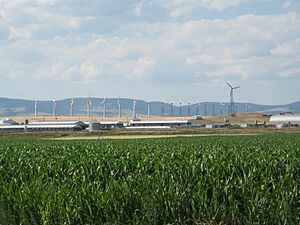Martinsdale, Montana facts for kids
Quick facts for kids
Martinsdale, Montana
|
|
|---|---|

Hutterite colony outside of Martinsdale with an array of reconditioned Nordtank wind turbines
|
|
| Country | United States |
| State | Montana |
| County | Meagher |
| Area | |
| • Total | 0.87 sq mi (2.3 km2) |
| • Land | 0.87 sq mi (2.3 km2) |
| • Water | 0.0 sq mi (0 km2) |
| Elevation | 4,817 ft (1,468 m) |
| Population
(2020)
|
|
| • Total | 43 |
| • Density | 49.3/sq mi (19.0/km2) |
| ZIP Code |
59053
|
| FIPS code | 30-48175 |
| GNIS feature ID | 2583827 |
Martinsdale is a small place in Montana, United States. It is located in the southeastern part of Meagher County. In 2020, about 43 people lived there.
Martinsdale used to be a stop on a big train line called the "Milwaukee Road." This train line is not used anymore. Today, Martinsdale is a local center for nearby farms and ranches.
Some famous people lived in Martinsdale. Grace Stone Coates, a poet, called Martinsdale home. She wrote books like Black Cherries. Also, Charles M. Bair, a very successful sheep rancher, lived here. His old family home is now a museum.
A new project called the Gordon Butte Pumped Storage Project is planned for Martinsdale. This project will be a power plant that uses water to make electricity.
You can find Martinsdale on Highway 294. It is just south of U.S. Route 12. The town is about 36 miles (58 km) east of White Sulphur Springs. White Sulphur Springs is the main town of Meagher County.
History of Martinsdale
Martinsdale was first called "Gauglersville." The name changed to Martinsdale in 1878. The town was named after Martin Maginnis. He was a delegate for the Montana Territory in Congress. He helped the town get its own post office.
See also
 In Spanish: Martinsdale (Montana) para niños
In Spanish: Martinsdale (Montana) para niños



